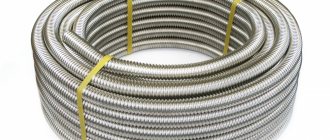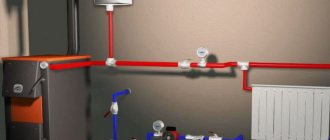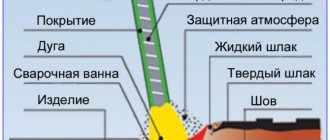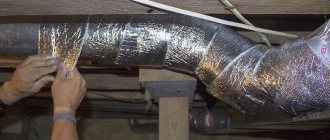Before reducing the diameter of a pipe, you should study the theory well. Reducing the diameter of a pipe at home can be useful to anyone who repairs various equipment with their own hands. Of course, if you need to reduce some element of the system, then it is best to use a special adapter and simply connect two pipes of different diameters. However, if you need to get a narrowed or bent tube from what you already have, you can resort to rolling. Rolling is the plastic deformation of a product into the desired shape.
Types of rolling and bending
Using rolling, you can make a product of the required shape from tubes. Moreover, using this method you can not only bend a product made of any metal, but also reduce the diameter.
The diameter of the pipe can be reduced using special equipment
Bending and changing the shape of a pipe is called rolling. This process received this name because the tool used for this is rollers.
Rolling is used for different purposes:
- To reduce the diameter of tubes made of different materials. This way you can deform thin-walled products made of stainless steel, cast iron, steel, etc.
- Using rolling, you can bend the product. In this case, you need to bend according to a special template.
- Extension and straightening. However, this is not recommended, as the product loses strength.
- Increase in diameter. However, this process is considered the most labor-intensive.
- Using a special pipe bender, you can bend the product into a coil with your own hands.
All the processes described are used in the manufacture and repair of tubular products. With their help, you can even make elements bent into a ring to decorate forged gates.
Eccentric flaring machine
The common eccentric tube flaring machine is used to produce quality parts. Among the features of this version, we note:
- Pressure is transmitted when force is applied through a mechanical element. The tip is made of high hardness metal.
- The delivery set includes many different tips, changing which you can get a surface of different shapes.
- The cost of such a mechanism is relatively low. A wide variety of metals can be used in manufacturing, for example, those with high corrosion resistance.
To increase the transmitted force, a long handle is used. It is fixed in a special holder.
Description of the essence of the process
Rolling is a rather complex process. However, in some cases it is quite possible to do it yourself. It is especially easy to bend thin-walled stainless steel and galvanized pipes.
Narrowing may also be necessary when constructing a metal pipeline. This method is used when you need to connect a pipe with a larger diameter to a product with a smaller one.
Self-tapering comes with some risks. The fact is that with this process, two forces directed in opposite directions act on the pipe. Therefore, the actions that can be performed with such elements are limited by several factors.
When reducing the pipe diameter, safety regulations must be followed
How is the pressure applied limited?
- First of all, the plasticity of the material is taken into account. The more plastic it is, the larger the radius it can be bent.
- You need to pay attention to how much thinner the pipe wall can be made for a particular product.
- It is necessary to check the bending strength of a particular metal. The more plastic the material, the higher this indicator will be.
- The limiting parameter of the radius, the transition from the side wall to the end, also matters.
- It is also necessary to pay attention to the surface quality of the product itself.
Each of these parameters must be taken into account. It is different for each wall thickness and for each specific diameter.
When reducing a pipe at home, you need to ensure that a large number of folds do not form on the metal. They reduce strength.
Standards for the diameter of sewer pipes established by regulations
When developing a sewerage system in a new house, it is necessary to rely on SNiP regulations 2.04.01085, which contains all the methods for calculating the main parameters of the diameter of the pipes used. The presented calculations take into account the main and secondary factors, which include the presence of a slope of horizontal sections, the angle of connection of drains with risers, and much more.
Based on the regulations, the following conclusions can be drawn:
- pipes with a diameter of 100 mm should be installed when organizing a sewer system in any house or apartment, if the amount of plumbing equipment does not exceed that established by the standards;
- pipes with a diameter of 50 mm can be installed to flush water from washbasins, bathtubs and urinals;
- in the case of sewerage in houses with more than 5 floors, pipes with a diameter of 150 mm are installed;
- pipes connecting several risers or having access to a well must have a diameter of 200 mm.
Connection diagram for cast iron pipes.
All sewer lines can be metal-plastic or cast iron. Metal-plastic pipes, unlike cast iron ones, as a rule, do not need to be replaced. They have a smooth surface on which dirt and grease deposits do not form. When taking into account the organization of the correct slope, there are also no deposits of sand or clay.
This feature of metal-plastic pipes allows the installation and joining of parts of different diameters. In this case, both metal-plastic materials and pipes made of metal-plastic and cast iron can be joined. The diameter of a metal-plastic pipe may be smaller than a cast iron pipe.
Why is work being done to reduce the diameter of the pipe? This reduces the cost of purchasing material and carrying out excavation work to organize the slope necessary for drainage. This is especially true in urban conditions, when it is necessary to maneuver the slope.
Bending stainless steel by hand
So, now we can talk directly about the narrowing process. This can be done either at the factory with a special tool, or at home with improvised means.
You can use a hammer. However, this method cannot be considered optimal, since the pipe can be severely deformed. In addition, the reduced part will turn out uneven, which will negatively affect the strength.
The best way is to use special pliers. They can be purchased at a specialty store, but they are not cheap. You can make the tool yourself. To do this, you need to take a pipe wrench, you can even use an old worn-out product. You need to remove the sponge from the movable lever, and instead of this sponge you need to install an insert under the half ring. Next, a half-ring of the required radius is made and installed on a movable lever. If you want to continue clamping pipes, you can make several rings with different diameters. This will increase the versatility of the products.
How to use special pliers:
- Take pliers with a mouth of at least half the diameter of the crimp ring. Cover the outer diameter with the pharynx.
- Place the pliers nut close to the device arm.
- Now you can turn the movable lever. Do this until it completely encircles the second half-perimeter.
- Next, squeeze both levers with force and turn the key 30 degrees.
- All these steps must be repeated until the pipe reaches the desired diameter.
Before bending stainless steel, you should first read the recommendations of specialists.
In this way you can give the required size. It is worth mentioning in advance that this work requires physical strength.
Main stages of work
First of all, cut a piece of threaded rod of suitable length. Diameter - at least 10 mm.
After this, using a grinder, the working part of the stud will need to be sharpened. Next, we make a longitudinal cut (about half the length of the hairpin).
We make a handle from a piece of wood. Then we drill a hole in it for the pin.
We insert a piece of the pin into the hole, screw the nut onto it and tighten it with a wrench.
Using this simple device, we trim the diameter at the end of one of the pipes. As you can see, there is nothing complicated here.
Details on how to make such a homemade tool can be seen in the video below. This idea was shared with us by the author of the YouTube channel Mr SunY
.
Rate this post
[Votes: 3 Average rating: 2.3]
Using a lathe
The easiest way to narrow a pipe is with a special machine. This process can be carried out even by a person who does not have great physical strength. After all, in this case, most of the work is done by technology.
To operate a lathe you must have certain skills
Using the template, you can bend not only a metal tube. Such a device is useful for giving the required shape to a piece of thick wire. The wire can also be bent by hand.
Sequencing:
- It is necessary to secure the pipe into the device socket. In this case, it is important to calculate the immersion depth of the workpiece. The stroke of the handle must coincide with the location of the blind hole.
- When you turn on the machine, you need to move the handle to the pipe. Next, click on the workpiece, and the loop begins.
- The material begins to heat up. This reduces the force but increases the ductility of the material.
- The handle must have a travel of at least 180 degrees. And the tool holders should be holes of the most popular size.
During the process, the product heats up and the material becomes pliable. Thanks to this, the diameter of the workpiece is easily reduced to the required values. Compressing a pipe with your own hands is difficult, but possible. To do this, you need to make a special device and learn how to use it correctly.
Source
Ways to reduce pipe diameter | Home repairs
Pipes made of steel and alloys from 0.2 mm
Various methods of mandrel and mandrelless cold drawing of pipes are used (Fig. 58). Mandrel drawing is designed to reduce the diameter and wall thickness of the pipe.
Rice. 58. Methods of pipe drawing:
The following methods of mandrel and mandrelless drawing are used.
Drawing on a stationary short cylindrical mandrel
, fixed to a rod, is the most common method (Fig. 58, a
). It is used for drawing pipes with a diameter of more than 8-10 mm
when you need to simultaneously reduce the diameter and wall thickness of the pipe.
Drawing of pipes of smaller diameter by this method is limited by the strength of the outgoing pipe, to the end of which the drawing pulling force Q is applied, and by the small diameter of the rod to which the mandrel is attached. Drawing on a long movable mandrel
moving with the pipe is used to produce extra-thin-walled pipes with a diameter of less than 8
-
Connection technique
Thin-walled steel pipes and fittings
The KAN-therm Steel system consists of thin-walled steel pipes and various configurations of fittings connected using press technology.
The KAN-therm Steel system is based on the technique of making crimp connections “Press” - crimping using the M crimp profile, which allows:
- create a three-point crimp of the O-Ring type seal, ensuring its appropriate deformation and tight fit to the surface of a thin-walled steel pipe,
- Completely enclose the space in which the O-Ring seal is inserted by pressing the edge of the fitting against the surface of the pipe, which prevents contamination from entering the fitting and provides a natural mechanical protection for the seal, as well as strengthening the mechanical connection.
Functions of brake pipes
Brake pipes are an integral element of the braking system of any car, which is responsible for stopping it at the right time. To understand the importance of such pipes for the operation of the brake system as a whole, you should at least superficially become familiar with the principle of its operation.
So, the process of stopping a car, for which the brake system is activated, consists of the following stages.
- If necessary, reduce the speed of the vehicle or stop it completely, the driver presses the brake pedal.
- The master cylinder piston connected to the pedal is activated and begins to act on the brake fluid.
- Under high pressure imparted by the master cylinder piston, fluid begins to flow through tubes and hoses into the cylinders of each wheel, affecting their pistons.
- Under fluid pressure, the pistons act on the brake pads, which are pressed against the brake discs, stopping the wheels from rotating.
Car brake system diagram
Obviously, brake pipes play a vital role in the operation of the entire braking system, and if they break, it completely fails. That is why the repair of these elements, which includes and, should be approached with all responsibility.
Single-pipe and two-pipe heating systems
Depending on the number of pipelines, systems are single-pipe, double-pipe and radial. In a one-pipe system, the coolant is supplied through one pipe, passes through the channels of the battery, gives off some of the heat, and flows back into the same pipe. The only advantage of such a system is ease of installation and a minimum amount of consumables. Thanks to these features, this installation scheme is used in the construction of multi-storey standard houses. Radiators are connected in series; accordingly, in devices remote from the boiler, the temperature of the coolant decreases. If the supply and return in the heating system are made by one pipe (lateral connection of the heating radiator from a vertical riser), it is impossible to regulate the temperature of a separate device, since narrowing or blocking the flow will affect the operation of all subsequent batteries. To ensure this possibility, it is necessary to install a jumper between the supply and return pipes.
In two-pipe systems, two pipes, supply and return, are separately connected to each battery. This increases pipe consumption, but the system works much more efficiently. It is recommended to connect a radiator to a two-pipe heating system diagonally, but other connection methods can be used depending on the location of the pipelines. The two-pipe system has several advantages:
- Natural and forced coolant circulation can be used.
- A heating connection diagram of any complexity can be used, taking into account the architectural features of the building.
- The temperature adjustment of each device is carried out separately and does not affect the operation of the system as a whole, which allows you to maintain different temperatures in individual rooms.
Collector wiring (radial system) involves supplying coolant to each battery (or room) directly from the boiler. The temperature of the devices is controlled using manifold control valves. This wiring method allows you to connect a heated towel rail or heated floor system to the heating system, regardless of the radiators.
Manifold for routing heating system pipes Manifold routing allows you to balance and adjust the system with a high degree of accuracy, however, in addition to its advantages, it also has many disadvantages:
- Expensive. The pipe flow rate increases significantly and the installation of additional equipment (manifold, hydraulic separator) is required.
- The pipe is laid in the screed in solid sections; joints in the screed are not allowed.
- Natural circulation is not enough; a circulation pump must be installed on each circuit. The use of electrical equipment makes the system dependent on power supply.
- Restrictions when choosing the type of pipe. Usually a metal-plastic pipe or cross-linked polyethylene is used. Connecting a radiator to polypropylene pipes, which are affordable, is impossible in this case.
Pipeline as the key to efficient operation
The cross-section of the pipes from which the heating system is installed is of great importance in the efficiency of its operation.
An incorrect calculation of diameters may not manifest itself for the time being.
For example, until you change the coolant temperature or try to start the system in a cold house.
If the heating was already working “on the edge,” then a change in temperature conditions can lower the pressure to such levels that the system simply will not work .
Features and interchangeability of radial press fittings for metal-plastic pipes
Radial press fittings are the most popular type of fittings for metal-plastic pipes .
The technology of radial press connection consists in crimping a metal press sleeve onto a pipe, which is put on the fitting of the press fitting. When using standard fittings, you must first calibrate the pipe and chamfer the inner edge of the pipe. The result is a reliable, durable connection with strength exceeding the strength of the pipe.
The sleeve is crimped using special pressing pliers using a manual, electromechanical or electro-hydraulic tool. Press pliers are replaceable equipment; their standard size is determined by the shape of the press profile (press profile) and the outer diameter of the pipe.
Design features of press fittings from various manufacturers
A radial press fitting from any manufacturer consists of a body, a press sleeve and a persistent plastic ring that secures the compression sleeve to the body. To ensure the required tightness of the connection, the fitting has O-rings. The shape of the body determines the type: straight connector, tee, elbow.
Press sleeve crimp profile
To obtain a high-quality connection, press pliers must press the sleeve in certain places, depending on the location of the o-rings.
Each press fitting system is characterized by acceptable compression profiles for the press sleeve, which are developed individually or selected from existing ones. In turn, each pressing contour corresponds to certain press jaws. To date, there are several dozen press profiles on the market; the most universal and common are the TH and U crimp profiles; you can also find H, B, F and others.
Manufacturers of press fittings are divided into two groups. Most of them produce universal fittings for which several types of press profiles, and therefore press tongs, are suitable. The exception is companies selling complete systems: Rehau, Uponor, Geberit, Viega. These companies have developed and marketed unique press fitting systems that require unique press jaws. Press jaws are expensive equipment and often tie installers to certain press profiles, and therefore systems, brands of press fittings.
Connection of two metal pipes for a chimney
A metal chimney is a compact and easy-to-use device designed to remove high-temperature combustion products from a stove or fireplace. The only drawback of a metal chimney is that the large length of the pipe makes transportation, storage and partial installation difficult. The problem is solved by assembling individual chimney fragments directly during the installation process. How to connect two metal chimney pipes so that the joints are strong and safe during operation?
To cook or not to cook?
The first thing that comes to mind is connecting pipes using electric welding. The idea is not the best, since the main range of chimney pipes is made of stainless steel. Welding work on such materials requires special equipment, which can only be found in specialized companies. In addition, such a connection belongs to the group of permanent connections, and therefore can create many problems during routine repairs.
Strong welded joints are unsafe due to the increased fragility of the seam. Constant static loads can initiate the formation of cracks through which toxic combustion products, in particular carbon monoxide, can enter the house.
Order current repairs of your copper roof and metal chimney from the professionals of our company today!
Advantages of collapsible connections and how to reduce the diameter of a pipe at home?
The optimal connection option is a collapsible one, ensuring proper tightness, safety and the possibility of dismantling.
- The easiest way to connect pipes of different diameters is using a clamp or an adapter selected to fit the pipes. The difference in diameters should be minimal. Reducing the cross-section of the chimney can negatively affect its performance. The so-called cravings can worsen by 20-30%. In practice, this means inefficient fuel combustion and a decrease in the efficiency of the system as a whole.
- Option two is a threaded connection using a threaded coupling. If necessary, the pipe can be disassembled, for example, to replace a damaged fragment.
- It is almost impossible to cut threads on large-diameter pipes manually, so the benefits of a threaded connection can be realized after contacting a specialized company.
A butt connection followed by a tie with a clamp is not the most successful option, since it is difficult to obtain an exact match at the joint. Heat leakage can lead to overheating of the clamp itself, which is unsafe from a fire point of view.
Home craftsmen offer their own connection option. To do this, shallow cuts are made along the diameter of one pipe, 30-50 mm long, by crimping them, the diameter can be reduced to a given value. The connection is partially telescopic, so overheating of the clamp is practically eliminated.
Practice has shown that increasing the diameter of the end of the pipe forces the design of the clamp to be more complicated; in addition, such a connection looks less compact.
Fittings for sandwich chimneys
Installation of a metal chimney
- Heating equipment manufacturers are aware of the complexity of the problem. Therefore, the range of connecting devices, so-called fittings, is constantly increasing due to new, more advanced models. In particular, easy-to-install fittings contribute to the effective connection of sandwich structures.
- There is a time-tested method for a reliable connection. The technology requires the extension of the inner pipe by 100 mm, which simplifies the application of a clamp or coupling. Upon completion of the work, the outer casing of the pipe is joined according to the selected pattern.
- In coaxial metal chimneys, an air layer is used as internal insulation. It is easier to seal such connections due to the lack of mineral wool thermal insulation.
The design of any connecting device must prevent toxic combustion products from entering residential premises.
Is it difficult to understand the installation instructions for ceramic tiles and metal chimneys? Then order professional installation from our company!
The influence of diameter on heating performance
The installation instructions for the heating system are unlikely to address the issues of pipeline calculation (also determine how to calculate the diameter of the heating pipe).
At the same time, when moving through a pipe, the coolant encounters several types of resistance and this must be taken into account when selecting the standard size:
- friction against walls . Due to this, part of the speed is lost,
- loss of speed when turning . It is impossible to carry out wiring around the apartment without turns (besides, there are turns at an angle of 90?),
- change in diameters . If you try to use different standard sizes when wiring around the apartment, then resistance to flow movement will also be observed at the junction points of different standard sizes.
Note! Narrowing the diameter of the heating pipe is undesirable. When wiring around the house, it is necessary to use the same standard size. An exception is allowed when the length of the circulation circuit is enormous; under such conditions it is possible to expand the speed of movement of the coolant by reducing D.
As for the pipeline itself, its main feature affecting the movement of coolant can be called the internal diameter (ID). The smaller it is, the greater the pressure and, on the contrary, with increasing pressure, the pressure in the system drops. This must be taken into account when selecting the diameter of the heating pipe.
Tags: antonl31
Comments 50
How on topic! And lawyers
The diameter could be rolled on a lathe.
maybe if you have a lathe
the main thing is desire, nothing is impossible)) well done
I guess you work at a service center...the guys there like to do this kind of bush work quietly, without fawning on the client so that...
I also work in a workshop (service). What, in your opinion, is not handicraft? You won't believe it, but pipes can be seamed.
Yes, I just remembered the topic; I had a story. In general, I made a capital purchase for a VAZ 2109 at the service center; there is a large store with spare parts during the service. from the service center they go there for spare parts. So, at the same time, I bought all the new pipes so that the antifreeze wouldn’t leak, otherwise I’m sick of it, it’s constantly leaking somewhere... well, they made me a capital investment that’s all right. and then probably half a year passed, I was doing something under the hood and noticed such a strange thing. The guy who did the capital work for me, he installed all my pipes with new ones except one. There is such a small pipe there, about 5 centimeters in total in length. The thermos is connected to his head. so this guy from the service not only didn’t change this pipe for me, he left the old one... for some reason he cut this pipe for me with wire cutters from a long pipe... and from the pipe of this pipe that he cut out with his own hands, antifreeze was leaking. When I noticed this topic, I immediately had a lot of questions. Why didn't he install my new one? I would at least leave the old one if I lost the new one... or I would go to the store, he would take another new one nearby, it costs a penny, he would include an extra 50 rubles in the price. don't care. So he didn’t install a new one and didn’t leave the old one and didn’t go to the store, for some reason he sat out of the stiffened old pipe and bit it out with pliers!))) It’s “good” that the current thermostats don’t last long, when replacing it and makeshift I replaced the pipe at the same time)) I just came across a topic: there is no pipe of the required diameter, no problem... we’ll stick one that we have in stock)))) ... I remembered that guy from the service center, I thought, too, you probably work at the service station) no offense)
whether this or that modification will work or not depends only on the quality of execution
And wrap it with blue tape
This is how it is done. Do you think this is a silicone hose? Nooooo...)))))
you can take a sheet of aluminum and quickly make any pipe. circumference 2 ave. and that's it! no need to damage the pipes
in order to make it from a sheet, you need this sheet to exist))) and why spoil the sheet?)))
damn. an elementary thing that was taught to tinsmith students at the FZU (Factory School) in the 50s. I'm sorry, but there's nothing revolutionary here. It’s just that few people understand how the art of locksmithing has degraded over the past 20-30 years. What was previously commonplace now turns into “obvious-incredible”.
the factories are standing, there are only managers in the country)))
and for me, as a production worker and engineer, this is very offensive.
Oh. As I understand you (c) PS, also an engineer and also a production worker)
the factories are standing, there are only managers in the country)))
and soon, instead of 10 fingers, people will have 2 tentacles, so that they can only poke at the gadget screen and pick their nose.
DIY rolling and bending
Before reducing the diameter of a pipe, you should study the theory well. Reducing the diameter of a pipe at home can be useful to anyone who repairs various equipment with their own hands. Of course, if you need to reduce some element of the system, then it is best to use a special adapter and simply connect two pipes of different diameters. However, if you need to get a narrowed or bent tube from what you already have, you can resort to rolling. Rolling is the plastic deformation of a product into the desired shape.
Types of rolling and bending
Using rolling, you can make a product of the required shape from tubes. Moreover, using this method you can not only bend a product made of any metal, but also reduce the diameter.
The diameter of the pipe can be reduced using special equipment
Bending and changing the shape of a pipe is called rolling. This process received this name because the tool used for this is rollers.
Rolling is used for different purposes:
- To reduce the diameter of tubes made of different materials. This way you can deform thin-walled products made of stainless steel, cast iron, steel, etc.
- Using rolling, you can bend the product. In this case, you need to bend according to a special template.
- Extension and straightening. However, this is not recommended, as the product loses strength.
- Increase in diameter. However, this process is considered the most labor-intensive.
- Using a special pipe bender, you can bend the product into a coil with your own hands.
All the processes described are used in the manufacture and repair of tubular products. With their help, you can even make elements bent into a ring to decorate forged gates.
Description of the essence of the process
Rolling is a rather complex process. However, in some cases it is quite possible to do it yourself. It is especially easy to bend thin-walled stainless steel and galvanized pipes.
Narrowing may also be necessary when constructing a metal pipeline. This method is used when you need to connect a pipe with a larger diameter to a product with a smaller one.
Self-tapering comes with some risks. The fact is that with this process, two forces directed in opposite directions act on the pipe. Therefore, the actions that can be performed with such elements are limited by several factors.
Classification of pipes by nominal cross-section
The nominal diameter of the pipe is one of the parameters that largely depends on the type of production of steel products.
In general, there are four types of pipes depending on the production technology:
- 20-500 mm - such products are produced by hot rolling in accordance with GOST 8732-78;
- 5-250 mm – similar values are defined by GOST 8734-75 for the cold rolling method;
- 10-1400 mm - this group of rolled pipes refers to welded products that have longitudinal seams, and their parameters are specified in GOST 10704-91;
- 160-2400 mm are the size limits for welded steel pipes with spiral seams, given in GOST 8696-74.
In this case, rolled steel pipes are presented in 38 standard sizes, the nominal diameters of which range from DN 5 to DN 2400. These also include four specialized groups, which are intended for hydraulic and pneumatic systems.
It is worth noting that the parameters of the nominal diameter of pipes are indicated not only in GOST with the standard classification and characteristics of the product range, but also in reference literature and special tables. There you can also find data on the maximum values of operating pressure in the system, longitudinal and transverse loads, as well as other information that may be related to the nominal diameter of the pipe and the type of its section.
Methods for connecting polyethylene and plastic communications having different diameters
Unlike metal pipes, the connection of which is impossible without the presence of a welder, various communications made of polyethylene of different diameters can be joined independently. Polyethylene pipes can be connected in two ways - by soldering or using fittings. To set up a fitting connection, no special equipment is required; a fitting and a crimp wrench are sufficient.
Also, joining can be done by soldering or cold welding. To carry out such work, the following tools exist:
- Pipe cutter or hacksaw for metal.
- Knife or sandpaper.
- Cleaner for degreasing material.
- Adhesive for gluing polyethylene parts.
- Fitting or coupling.
READ ALSO: how to clean white polypropylene pipes
Work on joining polyethylene communications of different diameters must have the following algorithm:
Connection diagram for plastic sewer pipes.
- The pipe is carefully measured and cut with a pipe cutter or hacksaw.
- The end that will be attached is cleaned with sandpaper or a knife. Burrs are removed. The outer side of the edge should be chamfered, which will allow the end to easily enter the reinforcement without scraping off the glue.
- All soldered surfaces must be treated with a special liquid to soften and degrease the material.
- Before applying glue, you should check how tightly the pipe is inserted into the fittings. Do not fit too tight (the material will scrape off the glue) or too loose (the connection will not be strong). It is necessary to make notes on the parts to be joined. This is necessary for a proper connection.
- It is necessary to apply glue evenly to the parts. The glue is applied liberally to the pipe and a thin layer to the fitting. You should use glue recommended only for this type of plastic or polyethylene.
- Immediately after applying the glue, the pipe must be inserted into the fitting until it stops and rotated 90 degrees. In this case, the glue will be evenly distributed over the parts. The parts are held in this position for 15 seconds (up to 30 seconds if work is carried out in a cold room). Excess glue that appears at the joint is removed with a soft cloth.
Water supply through connected communications should be carried out no earlier than an hour later.
Example of heating system calculation
In most cases, a simplified calculation is performed based on such parameters as the number of rooms, the level of its insulation, the difference in temperature flow and coolant velocity in the inlet and outlet pipelines.
The diameter of the heating pipe with forced circulation is determined in the following sequence:
- the total amount of heat that needs to be supplied to the room is determined (thermal power, kW), it is also possible to rely on tabular data,
- Having set the speed of water movement, the optimal D is determined.
Calculation of thermal power
As an example, a standard room with dimensions of 4.8x5.0x3.0m will be used. The heating circuit is with forced circulation; it is necessary to calculate the diameters of the heating pipes for distribution throughout the apartment. The main calculation formula looks like this:
The following notations are used in the formula:
- V – amount of room. In the example it is equal to 3.8•4.0•3.0 = 45.6 m3,
- ?t is the difference between the temperature outside and inside. In the example, 53?C is assumed,
- K is a special coefficient that determines the degree of insulation of the building. In general, its value ranges from 0.6-0.9 (effective thermal insulation is used, the roof and floor are insulated, at least double-glazed windows are installed) to 3-4 (buildings without thermal insulation, for example, change houses). In the example, an intermediate option is used - the apartment has standard thermal insulation (K = 1.0 - 1.9), K = 1.1 is accepted.
The total thermal power should be equal to 45.6•53•1.1/860 = 3.09 kW.
It is possible to use tabular data.
What parameters are needed?
In the description of the characteristics of a specific pipe, the following parameters may appear:
- The internal diameter is the main factor affecting system performance and is taken into account in the calculation.
- External - measured along the outer circumference of the pipeline, affects which holes will need to be drilled in walls and ceilings.
- Nominal, or conditional - approximately coincides with the internal cross-section of the pipe, is selected from a fixed series of numbers according to GOST , designated as DN 100. For common values, it is sometimes also designated as thread diameter in inches, for example: 1/2″, 3/4″.
Calculation procedure to choose the size
Let's consider an example of a typical calculation of the cross-section of a pipeline for heating a room of 40 m 2 .
- Let's calculate the optimal amount of energy to heat the room. For the middle zone, an insulated house and ceilings no higher than 3 meters, 1 kW is required per 10 m 2 of area . Or for 40 m 2 - 4 kW.
- We take a 20% reserve (in case of unexpected heat loss in the form of open windows and other factors): 4 * 1.2 = 4.8 kW, or 4800 W. There should be a heating radiator under each window in the room. there are 3 windows in our room , then these are 3 radiators, each
1.6 kW.
Attention! The thermal power is indicated in the data sheet for the heating battery. You can use a more powerful radiator, but not vice versa, otherwise the room will not warm up effectively enough.
- Now we turn to the table and find in the cells the closest power value to the calculated one , rounding up.
According to the table, this is 5518 W and you need to use a pipeline with a cross-section equal to 12 mm , and the speed of the coolant will be 0.6 m/s.
Despite the presence of other close values in the cells, the values from the zone limited by blue color are used, which contains acceptable values of the fluid velocity in the pipeline.
A suitable coolant flow rate through the pipes is from 0.3 to 0.7 m/s . A smaller one will lead to slow heating of the room and uneven heating of the radiators, and with a larger one, the liquid simply will not have time to warm up to the set temperature in the boiler heat exchanger and create noticeable noise.
Features of choice in a private house
If there is a central heating main, the selection of diameter is carried out similarly to apartment heating systems . However, if you are designing autonomous heating in a private house, then you need to take into account the type of coolant circulation: natural or forced.
Forced circulation of liquid is not so picky about the choice of pipeline cross-section, but the operation of a gravity-flow system with natural circulation very much depends on the diameter of the pipes in various sections.











